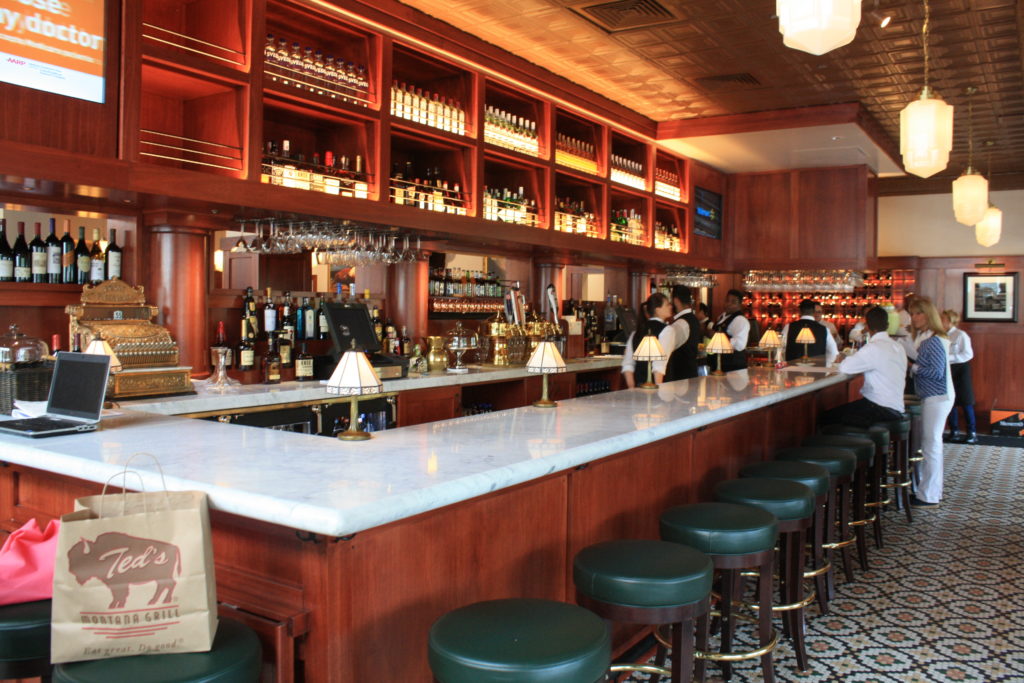Read how Ted’s Montana Grill leaned on their all-American authenticity for creative service solutions amidst the challenges of new restaurant regulations.
This blog is part three in a five-part series around how Restaurateurs are finding their new normal and operating under COVID regulations.
For classic American dishes served with a true dedication to sustainable ingredients and a commitment to simplicity, honesty, and authenticity, look no further than Ted’s Montana Grill. Their restaurants represent the classic saloons of the 19th century and service guests across the country with an experience that’s both unique and true to all-American ideals. Like many other restaurateurs continuing business throughout the COVID-19 pandemic, Ted’s Montana Grill adjusted their service to accommodate for new regulations. In our panel webinar about best practices for operating under these new restrictions, Bill Benz, Vice President of Information Technology with Ted’s Montana Grill, joined our discussion to share all the ways that Ted’s Montana Grill found success amidst the new challenges.
With locations across 16 states, it must be a challenge to stay on top of changing regulations. What systems do you have to ensure you’re receiving the most up-to-date information and communicating it back to your team?
Bill: We have a small corporate team, so internally we have one key person that monitors state regulatory updates and communicates the guidelines to the rest of the company. They stay in close connection with the restaurant associations in all 16 states, so we know what’s going on and ensuring that we’re following all the necessary guidelines. Outside of that, we’re also implementing additional responsible actions, like cleaning procedures above and beyond the state requirements. We really rely heavily on our location level management to understand and enforce local regulations and gauge the customer temperature in each market. We want to be responsible in our reopening processes, but we want to understand our communities and follow their lead as far as their comfort level.
Right now, we’re reopening where we can and to the level we can. Each state is a little different, so some locations are only open for to-go or patio service, others are allowed to welcome guests back for dine-in services. No matter how we reopen, our focus is to always exceed our guests’ expectations.
How are you getting the word out to your customers that your locations are open in some capacity?
Bill: Our Marketing team has been extremely active on social media, and they’ve worked hard to push the good news out through both our location pages and the national brand pages. We’re also sending out notices to our Ted’s Insider Club members, alerting them to any changes to service, openings, updates, etc., and inviting them back to the restaurant.
Are you making any changes to how you present your menu to accommodate the new safety realities brought on by COVID?
Bill: We printed and shipped disposable paper menus to all of our locations, and we also created cleanable postcards that have a QR code. Each guest gets to decide which option they prefer when they come to the location. A few years ago, we thought the QR code was dead, but COVID certainly brought it back and people seem to like the “bring your own device” option. Hopefully, it will be around for a while because, for us, it really makes sense. It’s easy and quick to change in real-time and there is an opportunity to make it a much more interactive experience for guests. Overall, it’s something we’ll monitor to see if our guests are receptive to it. Like we said before, we’re relying on our location-level teams to understand the customer temperature and adjust our strategy as necessary.
Have you made any changes to the items on your menu to accommodate the increase in the to-go business?
Bill: Ted’s Montana Grill is a fresh-to-order concept, so every meal is cooked to temperature when it’s ordered. That definitely presented some challenges because we want everything to meet the customer’s expectations, in the dining room and in the to-go box. Even before COVID, we identified that third-party was very hit-or-miss and felt it did not represent our brand appropriately. As a result, we shifted all efforts to improve our own takeout experience. We enhanced our to-go packaging, revised our process for staging, and tweaked our online ordering system to allow us to properly space out the orders coming in so that everything we served was as fresh as possible.
As we progressed through all the changes, we decided to move forward with three phases of our menu. When a location was open for to-go only we were often working with minimized staff or potential supply chain issues, so we limited the menu by removing items that didn’t travel well or were high-prep items. When a location began to reopen, we transitioned to sort of an intermediary menu where we added back in a few items, then watch sales figures before moving back to our full menu.
We also began a new business venture based on what we learned during COVID. When we were forced to close our dine-in service, our guests asked to purchase premium products since meat was scarce in grocery stores. We learned quickly that there was a demand for our products, so why not make them available in a broader capacity? In response, we launched Ted’s Butcher Shoppe, an online home-delivery service where consumers across the U.S. can order our premium steaks, bison, and beef grind. We’ve seen a great deal of success from the shop in a very short amount of time, and we’ll continue to add more items to the site as demand increases.
Are you offering to-go alcohol?
Bill: We have been offering beer and wine to-go, but it wasn’t something our customers demanded too highly. We noticed that our convenience store and grocery store counterparts did a great job by keeping up offerings for customers, so maybe people were getting their alcohol from other channels.
Even before COVID, it was necessary to get employee buy-in when making changes in the restaurant. How are you continuing communication and getting buy-in for all the new safety precautions and regulatory changes brought on by COVID?
Bill: It’s tough right, no one likes to wear the masks. But they’re mandatory – even if they’re not mandatory in a specific state, we’re making them mandatory. In a lot of ways, we’re just doing what we have to do. But we worked hard to communicate the importance of perception to our staff, and they’ve been extremely receptive to that ideology. We are under a microscope more now and people are sensitive to behaviors, so the safety precautions we’re taking are important not just for our guests’ wellbeing but also for our brand.
We are completing temperature checks for every team member, every shift, and we also require each person to answer our COVID questionnaire when they clock in through our POS system. They answer if they’ve traveled, been exposed to the virus, and if they’re experiencing symptoms. If they answer yes to any of those questions, they don’t work that day. Then the next screen shows them the touchpoints and cleaning procedures they’re responsible for per their role. It’s a constant reminder that they see and acknowledge every shift. The POS system also houses a whole COVID guidelines document on proper cleaning processes, so if they have any questions about what they’re responsible for, they can look it up there.
How have you adjusted your payment process to make it safer for your staff and customers?
Bill: We have made really significant changes to payments. For to-go orders, we only allow for credit cards now and the entire process is online, including signature and tip. It’s sped up service and reduced the contact between the guest and the server or hostess.
In the store, it’s been a little different approach because, while we don’t require a signature, we still want the guest to have the opportunity to leave a tip based on service. Right now, we’re exploring a payment option through the QR code. Guests can just scan the code, pay for their meal and leave a tip right on their own device, and never have to exchange any cards or receipts with the server. The demand for this kind of option is certainly growing now with COVID, and I think the whole industry is going to be watching adoption to see if it’s worth investing in that kind of technology permanently.
How are you blocking off tables or accommodating for capacity restrictions?
Bill: We are very fortunate in that we have beautiful, intimate booths in all our restaurants. The layout provides the perfect natural barrier between parties that is compliant with social distancing requirements. When we had to reduce capacity, we physically removed tables if we could, but most of our restaurants don’t have large storage areas. To adjust, we created table-top signs that say “Reserved for Bison,” and the table isn’t set with any condiments or silverware, so it’s pretty apparent that it’s closed. We also set up our reservation system and table management system to accommodate for restrictions and to make sure we’re not overbooking.
Lastly, what would be your best advice for anyone looking to navigate all these new regulations and be successful in moving forward?
Bill: You know, it’s a challenging environment right now, so it’s just important to keep doing the right thing. We are really doing our best to react to regulation changes quickly and listen to what our customers are asking of us. Hopefully, some things go back to pre-COVID normal soon, but then we also hope that some of the good things become the silver lining that sticks around, like the things that keep our staff safe. For now, we’re going to continue to adapt and deliver what our guests expect.
Interested in hearing more about how Ted’s Montana Grill and other top restaurant brands are handling new regulations and finding success with reopening? Watch our full panel webinar, Restaurateurs Share Best Practices for Operating Under COVID Regulations, on-demand.






